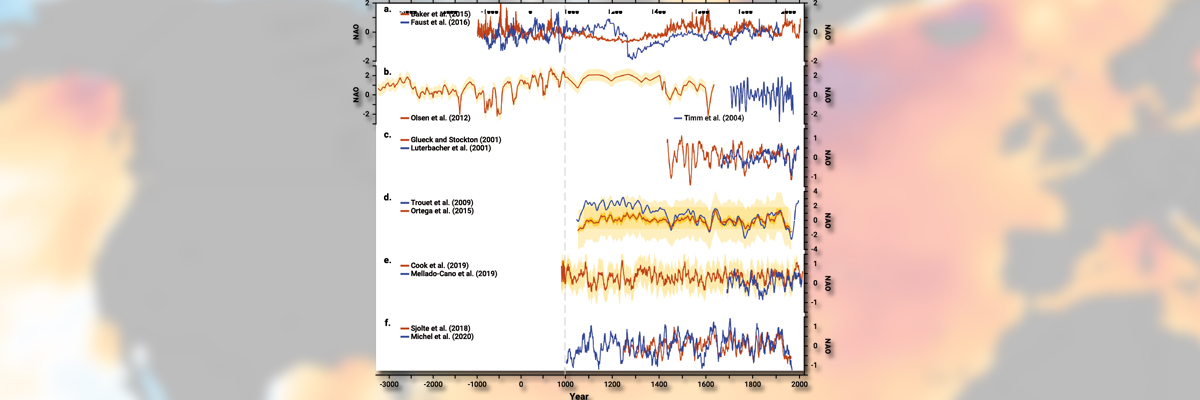26 de October de 2020
North Atlantic Oscillation (NAO) is the major atmospheric mode that controls winter European climate variability. Its strength and phase determine regional temperatures, precipitation and storm tracks in this part of the planet and around a large part of the northern hemisphere. Understanding its past evolution is crucial to contextualise their present and future behaviour. Now, a new study has identified some of the limitations of based proxy reconstructions of this and other modes of climate variability that show their evolution though the Holocene (last 11.700 years). Santiago Giralt, researcher at GEO3BCN, has participated in this study whose first author is Armand Hernandez, postdoctoral researcher at GEO3BCN-CSIC between the years of 2017 to 2019. The study has been recently published in Earths Sciences-Reviews journal.
Modes of climate variability are useful tools to study complex climate systems and their recurrent patterns over different temporal and spatial scales. Food safety, energy availability, water resources or the C02 absorption are often influenced by the changes of climate patterns that can be studied using this modes. “It is crucial that we gain improved knowledge of their long-term past evolution and interactions over time to contextualize their present and future behaviour and to take the most suitable management decisions”, says Hernandez.
The study reviewed the literature focused on proxy-based reconstructions of the main modes of climate variability, such as El Niño Southern Oscillation (ENSO), the North Atlantic Oscillation (NAO), the Pacific Decadal Variability (PDV), the Northern and Southern Annular Modes (NAM and SAM) and the Indian Ocean Dipole (IOD). “We selected the most studied modes and with more effects over global and regional climates”, points out Armand Hernández.
Researchers identified some of the main issues addressed by reconstructions to understand the spatial and temporal evolution of these modes. According to Armand Hernández, the work shows that “there are scarce quantitative studies beyond the last millennium and these reconstructions don’t show always the same evolution patterns. This can be partly due to the used methodology and the proxy and natural archives selected”. Tree rings, ice, marine and lacustrine sediments, corals, speleothems and historical documents are the most commonly used archives to carry out high-resolution proxy based reconstructions of the evolution of the modes of climate variability.
The lack of instrumental records beyond 19th Century is one of the main issues for reconstructions.”Multidecadal variations occur in all the modes of climate variability, and the lack of long-term instrumental data for these fluctuations present important challenges to climate science”, study says.
Researchers reviewed previous quantitative proxy-based studies of these modes that were accessible from open access repositories. “We analysed the differences among reconstructions for each mode using correlation analysis”, explains Hernandez.
One of the major issues identified in this review is whether these modes have affected or not the climatic variables in the same way over the time, known as stationarity. According to Hernández, “if the behaviour of these modes has not been the same over time and they have produced different climatic conditions in a region even with the same disposition of the modes, this is challenging for the reconstructions”.
The possible interferences in the reconstructions related with the interaction between the modes are another of the issue identified by the study. Moreover, the authors notes that dating uncertainties “are very difficult to constrain and contain associated errors”.
The study also analysed the influence of external factors over these modes. “The reviewed evidences suggest that variability of the modes of climate variability can be conditioned by external factors such as volcanism, solar activity or orbital forcing”, study says.
Researchers from the Royal Holloway University of London, Durham University, Barcelona Supercomputing Centre (BSC), the University of Reading , IDAEA-CSIC and CREAF-CSIC, among others institutions, have been involved in this research.
This work is an extended version of a chapter from the 6th Assessment Report of the International Panel of the Climate Change (IPCC) devoted to the climatic reconstructions and the study of modes of climate variability, which is currently being written by Hernández. At the same time, another study from Hernández focussed on the reconstruction of the NAO from the Iberian Peninsula during the last 2000 years has been recently published in the journal Scientific Reports. Santiago Giralt is also among the authors of the study, which is part of the doctoral thesis of Guiomar Sánchez, defended in 2016.
Reference
Hernández, A., Martin-Puertas, C., Moffa-Sánchez, P., Moreno-Chamarro, E., Ortega, P., Blockley, S., Cobb, K. M., Comas-Bru, L., Giralt, S., Goosse, H., Luterbacher, J., Martrat, B., Muscheler, R., Parnell, A., Pla-Rabes, S., Sjolte, J., Scaife, A. A., Swingedouw, D., Wise, E., & Xu, G. (2020). Modes of climate variability: Synthesis and review of proxy-based reconstructions through the Holocene. Earth-Science Reviews, 209, 103286. https://doi.org/https://doi.org/10.1016/j.earscirev.2020.103286
Further information
Hernández, A., Sánchez-López, G., Pla-Rabes, S. et al. A 2,000-year Bayesian NAO reconstruction from the Iberian Peninsula. Sci Rep 10, 14961 (2020). https://doi.org/10.1038/s41598-020-71372-5

